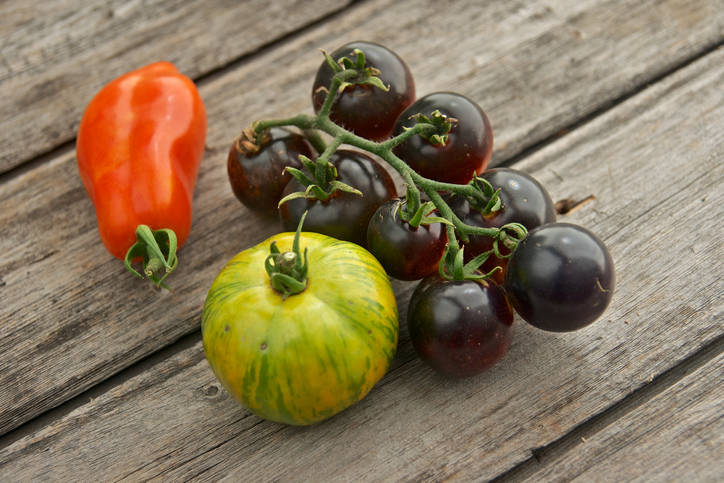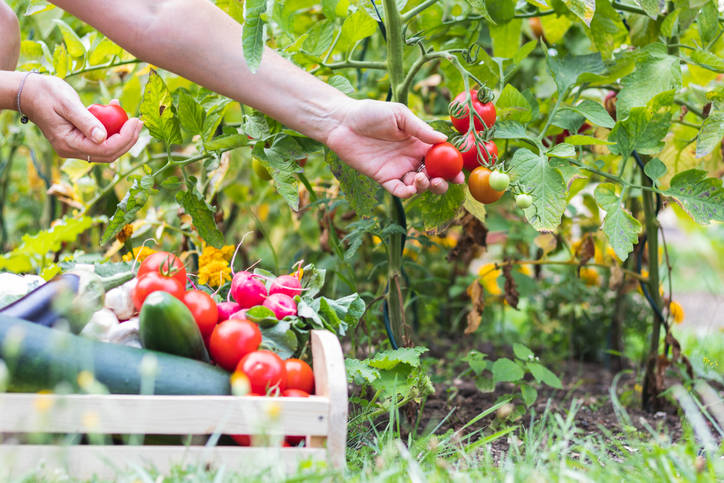In Season: Tomatoes, America’s most popular vegetable
Legend has it that sometime, during or after the Great Depression, a farmer paid off his entire mortgage by developing and selling a new variety of tomato. That wildly successful tomato variety has since come to be called “Mortgage Lifter” and is available today from many online seed stores.
The debate rages as to whether a tomato is a fruit or a vegetable. Most botanists would classify the tomato as a fruit. In 1893 however, the U.S. Supreme Court decided that tomatoes are classified as a vegetable for taxation purposes. Tomatoes may be the most popular vegetable grown in the average American backyard garden plot and it is easy to see why.
Tomatoes can be eaten fresh or made into sauces and canned for long-term storage. They can also be frozen, dehydrated, and pickled. There is almost no limit to their versatility.
Though tomatoes can be traced to the Aztecs, European explorers introduced the fruit around the globe, and it can be found in foods in almost every culture. However, not every variety of tomato will do well in every climate.
In our region, the time is now to plant tomatoes, either from direct seeding or transplanting a purchased seedling. When choosing varieties to plant, first consider if you would like determinate or indeterminate tomatoes.
Determinate: Determinate tomatoes grow only to a certain height and tend to be more bush-like in appearance. They will produce a lot of fruit all at once, which is great for those who like to can their harvest or have an early crop. Determinate tomatoes may or may not need support, depending on the variety. When support is needed, it is best to use tomato cages.
My favorite determinate varieties for our climate are Roma, Heatmaster, and Green Zebra.
Indeterminate: Indeterminate tomatoes grow long vines and produce fruit all throughout the growing season. The vines of some varieties can grow up to 15 feet long. These types of tomatoes can be left to grow along the ground. Allowing them to trail along the ground though can cause disease and pest issues. I prefer to trellis indeterminate tomatoes.
My favorite indeterminate tomatoes for our climate are: San Marzano, Hawaiian tropic, Yellow pear, Sweet 100, Sungold, and Black Cherry.
Once you have chosen the varieties that you would like to plant you will need to carefully transplant them to your garden. For successful transplanting follow these steps.
5 steps to successfully transplanting tomato seedlings
1. Tomatoes should be spaced no closer than 1 foot apart if trellising and 2 feet apart if not. This will reduce disease and increase air flow.
2. It is good to set up your supports like cages or trellises before you plant out your tomato. This will assure that you do not injure the roots of the plant when putting in the supports.
3. Remove any fruit and flowers before transplanting. This will allow your seedling to focus on root development after planting. Continue to remove any fruit or flowers that you see forming for the next two weeks after planting.
4. Dig the hole for your seedling as deep as the pot and twice as wide in circumference. I like to add a scoop of worm castings into my planting hole, but fish emulsion is also a good option for feeding your tomato seedling.
5. Remove all but the top two sets of leaves and bury the entire stem up to the bottom of the leaves. Tomatoes will sprout roots from the stem leading to a stronger plant in the long run.
How to care for your tomatoes
Watering: Within a few weeks of transplanting, your seedling should take root and begin putting on new growth. Keep the soil moist with regular watering. In my garden I water daily when temperatures are over 80 degrees. My garden is set up with driplines that are set to go off for 10 minutes once per day at this time of year. When the temps get above 90 degrees the driplines go off for the same amount of time but twice per day, morning and early afternoon.
Protection: Once the soil has warmed you should apply mulch around your plants. This will help to conserve water, keep the roots cool, and prevent disease, which occurs when water splashes onto the leaves.
Nutrition: If you fed your tomatoes when you planted them then you do not need to feed them again until they begin setting fruit. After that point I recommend feeding them every other week. I like to feed my tomato plants with compost tea that I make by soaking unfinished compost in water for 24 hours. I strain the liquid from the solids and pour a cupful around the base of each plant. The solids are then put back into the compost heap.
Companion planting: Planting basil with your tomatoes helps to deter pests and allows you to grow more in less space. I also like to plant flowers, such as alyssum with my tomatoes. It is a low-growing flower that provides a living mulch and helps attract pollinators to your garden, increasing the pollination of your tomatoes.
Check your plants at least once a day to catch issues early as they arise.
Common tomato issues to look for
Hornworm damage: One common issue you may see is damage from tomato hornworms. Tomato hornworms are green caterpillars of the hummingbird moth. They can defoliate a tomato plant in a single day. They are hard to spot but you may notice your tomato is suddenly missing several leaves or big bites have been taken out of the fruit itself.
One way to find the hornworms is to look for their droppings. Once you see the large black dots, check the leaves above. Hornworms can be plucked off and killed or given to chickens. When you see one there are usually many more.
Blossom end rot and cracked fruit: Blossom end rot looks like a black spot at the the bottom of the tomato as it forms. Blossom end rot and cracks in the fruit are both caused by uneven watering. To avoid this issue water your garden on a regular schedule and check your irrigation often for problems. Tomatoes with this kind of damage can still be eaten. For blossom end rot just cut the spot off before eating.
Blight: There are two kinds of blight, early and late. It appears as dark spots on the leaves and is a fungal disease caused by conditions that are too moist or crowding of plants. This can happen even in our dry climate if watering is not done properly or after periods of heavy rain. To avoid the issue, water the soil instead of leaves.
If you run into blight, treat quickly as the disease can spread rapidly. There are fungicides available to treat blight. I do not use not use products like these in my garden. If you choose to use it be sure to follow the manufacturer’s directions on the label. I find that it is simply enough to trim and dispose of affected leaves if caught early. Affected leaves should not be composted. Either burn them or throw them out in your trash.
Now that you know what common issues to look out for and how to plant tomatoes, with just a little time and dedication you can be enjoying a delicious ripe tomato from your own garden in a few months’ time. To me there is nothing like a tomato in season.
Terri Meehan is the Founder of Southern Nevada Gardening Association a regional group. She is a garden mentor and local farmer in Pahrump. Send questions or comments to her at sonvgarden@gmail.com


















